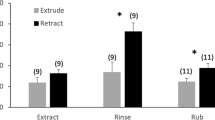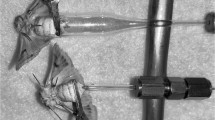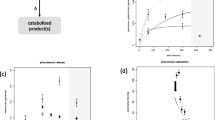Abstract
To attract a mate, females of most moth species synthesize and emit sex pheromone from a specific gland in a behavior termed “calling”. In a broad temporal sense, calling behavior and pheromone synthesis are synchronized through the overlap of their circadian rhythms. However, the limited amount of pheromone a female produces each day must be managed so that pheromone is emitted at a sufficient (to attract males) mass emission rate (MER) over the entire calling period, typically many hours. We are studying pheromone synthesis and emission in the moth Chloridea (formerly Heliothis) virescens (family Noctuidae). One way that female C. virescens manage pheromone over their calling period is by calling intermittently; the period between calling bouts allows females to replenish pheromone, and resume calling at high MERs. However, militating against replenishment is loss of pheromone through putative catabolism. In this paper, we examined three aspects pertaining to pheromone MER in C. virescens: (i) the effect of adult feeding on calling behavior, (ii) the effect of certain behavioral/physical parameters on MER, and (iii) the relative loss (putative catabolism) of pheromone in retracted (non-calling) and everted (calling) glands. We found that (i) adult feeding increases calling duration, consistent with the known concomitant increase in pheromone production, (ii) various physical factors relating to the gland, including degree of eversion (surface area), orientation to airstream, and air velocity over the gland influence MER, and (iii) putative catabolism occurs in both retracted and everted glands, but substantially less pheromone is lost in the everted gland primarily because of the high MER when the gland is first everted. Together, these data demonstrate that, over the calling period, the efficient use of pheromone for emission by female C. virescens is dependent on the interaction among synthesis, storage, catabolism, and calling behavior.




Similar content being viewed by others
References
Allison JD, Cardé RT (eds) (2016a) Pheromone communication in moths: evolution, behavior and application. University of Caifornia Press, Oakland, California
Allison JD, Cardé RT (2016b) Variation in moth pheromone: causes and consequences. In: Allison JD, Cardé RT (eds) Pheromone communication in moths: evolution, behavior and application. University of California Press, Oakland, California, pp 25–41
Aubrey JG, Boudreaux HB, Grodner ML, Hammond AM (1983) Sex pheromone-producing cells and their associated cuticle in female Heliothis zea and H. virescens (Lepidoptera: noctuidae). Ann Entomol Soc Am 76:343–348
Cardé RT (2016) Moth navigation along pheromone plumes. In: Allison JD, Cardé RT (eds) Pheromone communication in moths: evolution, behavior and application. University of California Press, Berkeley, California, pp 173–189
Choi MY, Groot A, Jurenka RA (2005) Pheromone biosynthetic pathways in the moths Heliothis subflexa and Heliothis virescens. Arch Insect Biochem Physiol 59:53–58
Foster SP (2009) Sugar feeding via trehalose haemolymph concentration affects sex pheromone production in mated Heliothis virescens moths. J Exp Biol 212:2789–2794. https://doi.org/10.1242/jeb.030676
Foster SP (2016) Toward a quantitative paradigm for sex pheromone production in moths. In: Allison JD, Cardé RT (eds) Pheromone communication in moths: evolution, behavior and application. University of California Press, Oakland,, CA, pp 113–126
Foster SP, Anderson KG (2012) Synthetic rates of key stored fatty acids in the biosynthesis of sex pheromone in the moth Heliothis virescens. Insect Biochem Mol Biol 42:865–872
Foster SP, Anderson KG (2015) Sex pheromones in mate assessment: analysis of nutrient cost of sex pheromone production by females of the moth Heliothis virescens. J Exp Biol 218:1252–1258. https://doi.org/10.1242/jeb.119883
Foster SP, Anderson KG (2018) Differential pheromone sampling of the gland of female Heliothis virescens moths reveals glandular differences in composition and quantity. J Chem Ecol 44:452–462. https://doi.org/10.1007/s10886-018-0954-0
Foster SP, Anderson KG (2020a) The effect of pheromone synthesis and gland retraction on translocation and dynamics of pheromone release in the moth Chloridea virescens. J Chem Ecol 46:581–589. https://doi.org/10.1007/s10886-020-01198-y
Foster SP, Anderson KG (2020b) Sex pheromone biosynthesis, storage and release in a female moth: making a little go a long way. Proc Roy Soc B: Biol Sci 287:20202775. https://doi.org/10.1098/rspb.2020.2775
Foster SP, Johnson CP (2010) Feeding and hemolymph trehalose concentration influence sex pheromone production in virgin Heliothis virescens moths. J Insect Physiol 56:1617–1623. https://doi.org/10.1016/j.jinsphys.2010.06.002
Foster SP, Anderson KG, Casas J (2018) The dynamics of pheromone gland synthesis and release: a paradigm shift for understanding sex pheromone quantity in female moths. J Chem Ecol 44:525–533. https://doi.org/10.1007/s10886-018-0963-z
Foster SP, Anderson KG, Casas J (2020) Calling behavior and sex pheromone release and storage in the moth Chloridea virescens. J Chem Ecol 46:10–20. https://doi.org/10.1007/s10886-019-01133-w
Groot AT (2014) Circadian rhythms of sexual activities in moths: a review. Front Ecol Evol 2. https://doi.org/10.3389/fevo.2014.00043
Holdcraft R, Rodriguez-Saona C, Stelinski L (2016) Pheromone autodetection: evidence and implications. Insects 7:17
JMP (2015) JMP Version 12.2.0. SAS Institute Inc., Cary, North Carolina
Jurenka R (2017) Regulation of pheromone biosynthesis in moths. Curr Opinion Insect Sci 24:29–35. https://doi.org/10.1016/j.cois.2017.09.002
Li R-T, Huang L-Q, Dong J-F, Wang C-Z (2020) A moth odorant receptor highly expressed in the ovipositor is involved in detecting host-plant volatiles. eLife 9:e53706. https://doi.org/10.7554/eLife.53706
Ma PWK, Ramaswamy SB (2003) Biology and ultrastructure of sex pheromone-producing tissue. In: Blomquist GJ, Vogt RC (eds) Insect pheromone biochemistry and molecular biology. Elsevier Academic Press, London, pp 19–51
Ma PWK, Roelofs WL (2002) Sex pheromone gland of the female European corn borer moth, Ostrinia nubilalis (Lepidoptera, Pyralidae): ultrastructural and biochemical evidences. Zool Sci 19:501–511
Mackay D, van Wesenbeeck I (2014) Correlation of chemical evaporation rate with vapor pressure. Environ Sci Technol 48:10259–10263. https://doi.org/10.1021/es5029074
Murlis J, Willis MA, Cardé RT (2000) Spatial and temporal structures of pheromone plumes in fields and forests. Physiol Entomol 25:211–222. https://doi.org/10.1046/j.1365-3032.2000.00176.x
Nojima S, Classen A, Groot AT, Schal C (2018) Qualitative and quantitative analysis of chemicals emitted from the pheromone gland of individual Heliothis subflexa females. PLoS One 13:e0202035. https://doi.org/10.1371/journal.pone.0202035
Raina AK, Wergin WP, Murphy CA, Erbe EF (2000) Structural organization of the sex pheromone gland in Helicoverpa zea in relation to pheromone production and release. Arth Struct Devel 29:343–353
Roelofs WL, Hill AS, Cardé RT, Baker TC (1974) Two sex pheromone components of the tobacco budworm moth, Heliothis virescens. Life Sci 14:1555–1562. https://doi.org/10.1016/0024-3205(74)90166-0
Shorey HH, Hale RL (1965) Mass-rearing of the larvae of nine noctuid species on a simple artificial medium. J Econ Entomol 58:522–524
Torres-Vila LM, Rodríguez-Molina MC, Stockel J (2007) Delayed mating reduces reproductive output of female European grapevine moth, Lobesia botrana (Lepidoptera: Tortricidae). Bull Entomol Res 92:241–249. https://doi.org/10.1079/BER2002155
Turgeon JJ, McNeil JN (1983) Modifications in the calling behaviour of Pseudaletia unipuncta (Lepidoptera: Noctuidae), induced by temperature conditions during pupal and adult development. Can Entomol 115:1015–1022. https://doi.org/10.4039/Ent1151015-8
Umbers KDL, Symonds MRE, Kokko H (2015) The mothematics of female pheromone signaling: strategies for aging virgins. Am Naturalist 185:417–432. https://doi.org/10.1086/679614
Vickers NJ, Christensen TA, Mustaparta H, Baker TC (1991) Chemical communication in heliothine moths. J Comp Physiol A 169:275–280. https://doi.org/10.1007/BF00206991
Wyatt TD (2014) Pheromones and animal behaviour: chemical signals and signatures, 2nd edn. Cambridge University Press, Cambridge, UK
Acknowledgments
This work is supported by the USDA-National Institute of Food and Agriculture, Hatch project number ND02363. We are grateful to USDA–NIFA for an Instrument Grant, 2015-07238 contributing, in part, to the purchase of the GC/MS system.
Data availability
Data for this study are freely available from the senior author upon request.
Code Availability (Software Application or Custom Code)
Not applicable.
Funding
USDA-NIFA Hatch grant and Instrument grant.
Author information
Authors and Affiliations
Contributions
All authors contributed to the study conception and design. All authors read and approved the final manuscript.
Corresponding author
Ethics declarations
Conflicts of Interest/Competing Interests
The authors have no relevant financial or non-financial interests to disclose.
Rights and permissions
About this article
Cite this article
Foster, S.P., Anderson, K.G. Some Factors Influencing Calling Behavior and Mass Emission Rate of Sex Pheromone from the Gland of the Moth Chloridea virescens. J Chem Ecol 48, 141–151 (2022). https://doi.org/10.1007/s10886-021-01334-2
Received:
Revised:
Accepted:
Published:
Issue Date:
DOI: https://doi.org/10.1007/s10886-021-01334-2




